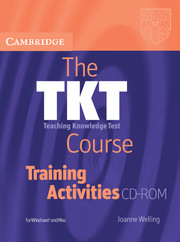2.3 - Lesson plan labelling
Published online by Cambridge University Press: 09 February 2024
Summary
Instructions
1. Ask trainees to stand and come to an open space in the classroom. Give one strip of card to each trainee and tell them not to show it to anyone else.
2. Explain that each card contains one stage or step in a lesson plan. The trainees must work together to reconstruct the correct order of the lesson, by forming a human chain. Nobody may let go of their card!
3. Have trainees mingle and tell each other the step on their card; they should try to work out where they belong in relation to the stages they hear. Gradually the group forms a tentative order.
4. Now have the trainees read their own stage out loud again, for all to listen to, in the ‘correct’ order. As others read, trainees listen and try to get an overview of the lesson plan.
5. Prompt the trainees by eliciting what type of class this is: Are there any main distinguishable parts to the class? (First the topic lead-in, then gist listening.) Trainer may also prompt when the trainees have the order wrong: Would you give out the drawing materials before or after the first reading?
6. When trainees are completely happy with the order, have them sit down and hand out copies of the complete worksheet. Have trainees compare their order with the order on the worksheet. Discuss any differences as a whole group.
7. Finally, refer the trainees to the glossary terms at the end of the worksheet and have them match them to the lesson plan stages. Conduct feedback on this and answer any questions.
Variation
A less challenging alternative is to have the trainees order the lesson in pairs, giving a set of cards (2.3B) to each pair. The human chain can then be used as a feedback device to check the answers. Ask a volunteer from one pair to stand up with the first card. Then a volunteer from a second pair stands, with the second card, next to the first person and so on.
- Type
- Chapter
- Information
- The TKT Course Training Activities , pp. 54 - 56Publisher: Cambridge University PressFirst published in: 2024

